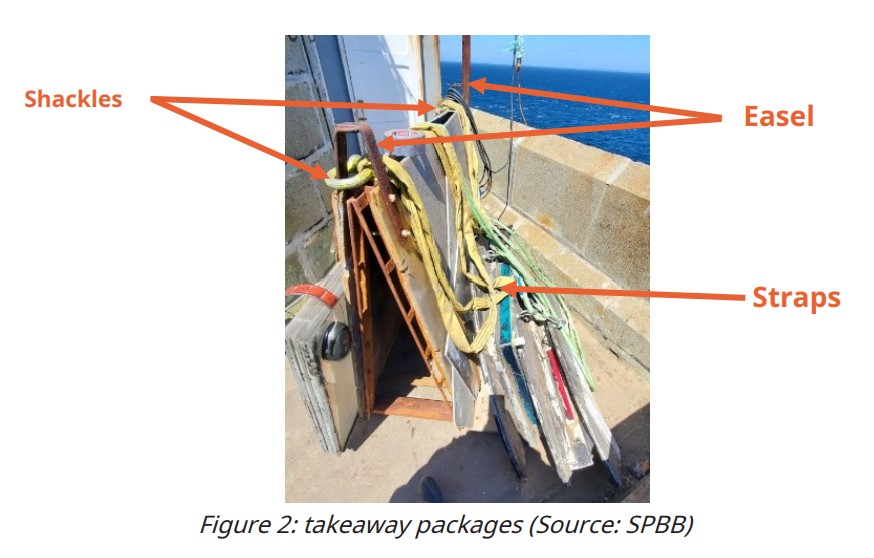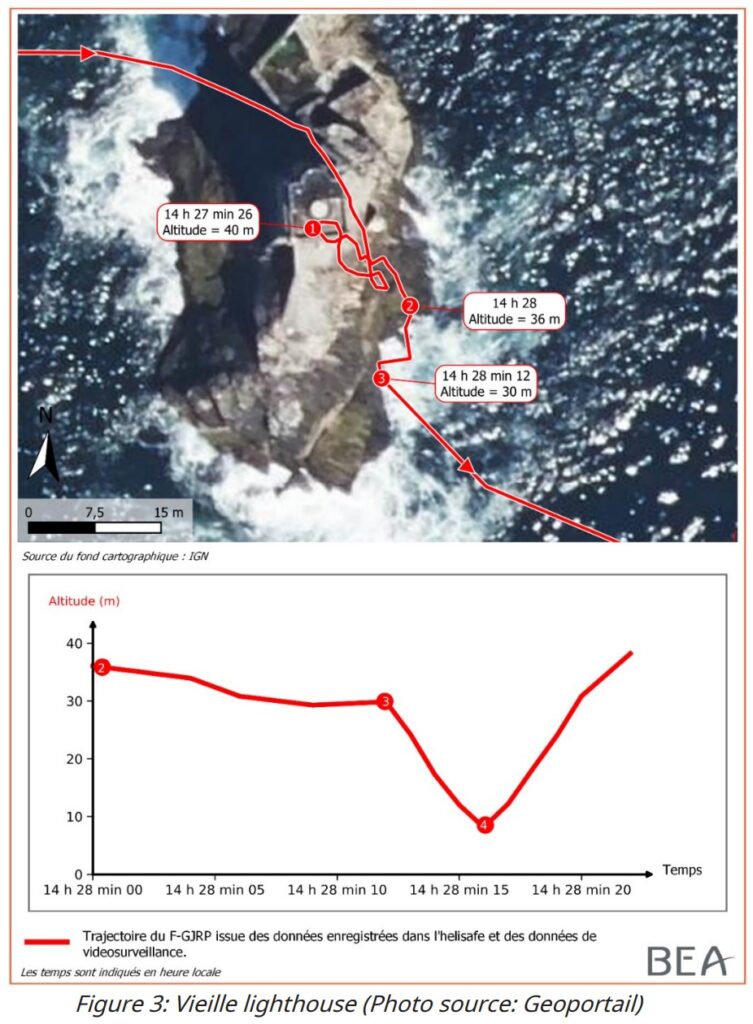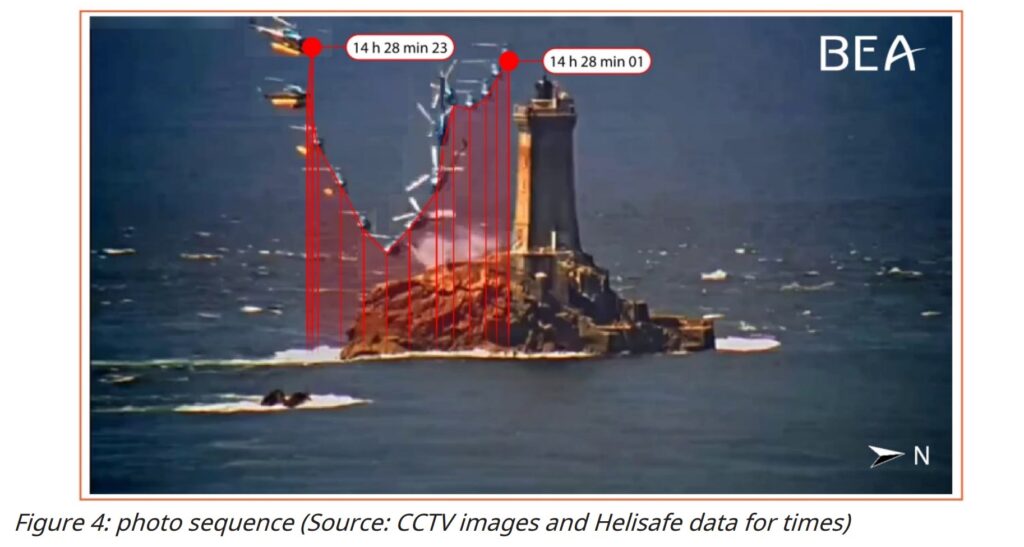Lighthouse HESLO Accident (AS350B2 F-GJRP, La Vieille, Brittany)
On 6 July 2022 Airbus AS350B2 F-GJRP operated by Mont Blanc Hélicoptères, part of HBG France, was involved in an dramatic loss of control accident during a Helicopter External Sling Load Operation (HESLO) in support of maintenance at La Vieille lighthouse, off Pointe du Raz, Brittany for the Brest Lighthouses and Beacons Service (SPBB). One member of the ground party was crushed between a load and the stone balconey of the lighthouse.

Mont Blanc Hélicoptères Airbus AS350B2 HESLO Accident, La Vieille Lighthouse (Credit: via BEA)
The accident was caught on video:
The Accident Flight
The BEA issued their safety investigation report in French on 21 September 2023.
At c09:00 the helicopter landed at a staging area on the mainland, a short distance from the lighthouse.
The SPBB site manager was present at the landing site but the SPBB ground party was already at the lighthouse. The helicopter operator’s Task Specialist was briefed that they would be unable to travel to the lighthouse to inspect the loads due to tidal conditions. Furthermore the SPBB team at the lighthouse, who were to hook up the returning loads, contrary to normal practice, had no radio.
At 10:45 the first operations commenced with a 30 m sling. On board were the pilot (4,130 flight hours, 2,310 on type) and the Task Specialist, who was in the cabin, in the left rear seat, to provide the pilot with guidance. The wind was from the north at around 6 kt, gusting 8 kt. Initially loads were moved from the base of the lighthouse.
The pilot explained that during lighthouse missions, he uses the rearview mirror, rather than the vertical reference window, to prevent his gaze from being focused on the waves, which, according to him, can lead to spatial disorientation. With the 30 m sling to collect packages at the bottom of the lighthouse, its visual reference was the weather vane at the top of the dome of the Vieille lighthouse.
A sea mist around noon led the pilot to pause flying. The wind strengthened and was from north-northwest, at 15 kt, gusting 20 kt.
Operations commenced again at 14:00. One more load was moved from the base of the lighthouse, then a 10 m sling was fitted to move load from the balcony of the lighthouse that surrounds the lantern. The first was a 326 kg load.

The pilot explains that piloting with a 10 m sling to recover the loads at the top of the lighthouse was simpler due to the position of the helicopter in relation to the dome of the lighthouse.
However there was concern about the strengthening wind. The BEA explain that:
From 14:26:55., the pilot turned to follow a westerly course before turning towards the lighthouse five seconds later. It then turns left to translate vertically to the lighthouse balcony facing west, at an altitude of approximately 40 m. From 14:27:26 ( point❶), the pilot turns to the left and translates eastwards slightly south of the lighthouse balcony.
During this period, vertical or close to the vertical of the lighthouse terrace, the pilot sees in the rearview mirror that an SPBB agent on the terrace is trying to catch the hook. After taking his eyes off the rearview mirror to maintain control of the helicopter and the trajectory, the pilot no longer sees the hook in the rearview mirror and deduces that either the hook is on the ground or the agent has grabbed it to attach. The altitude reaches 36 m (point❷) and the audible alarm “One hundred feet” (height less than 100 ft) is triggered shortly afterwards.
The pilot does not see the hook in vertical reference through the window located below on his right, which confirms to him that the agent has hooked the load. The pilot indicates that this search by vertical reference could have led him to apply a slight action to the right to the cyclic.
At the same time, the agent who hooked the straps to the sling hook sees that the helicopter is drifting with the wind on the way down, which begins to stretch the sling horizontally.
The agent then decided to unhook the straps and only managed to unhook the strap folded in two before the load pulled by the helicopter pinned him against the granite parapet of the terrace.
The helicopter is still drifting toward the southeast and the task specialist repeatedly asks the pilot to get back on course. The pilot does not hear it because of the audible alarm “One hundred feet” which sounds continuously in his headphones.
The pilot’s action on the collective pitch control and tensioning of the sling reduces the main rotor speed . The pilot hears the task specialist shout “largo” [slow] when, a few seconds later, the helicopter tilts forward when the strap of the load attached to the sling breaks (point❸).
The pilot lowers the collective pitch and pushes the cyclic forward to avoid contact between the sling and the tail rotor. He triggers emergency flotation system in the event of a ditching.
For approximately one second, the rotor rpm alarm sounds and the oil pressure warning light comes on (due to the unusual attitude of the helicopter).
The helicopter picks up speed, the rotor rpm increases…
Engine oil released through the breather caused the smoke visible in the video.
The minimum height of the helicopter above the ocean surface was estimated at 8 meters (point❹).
The return to the landing site was at a speed of between 60 and 80 kt.
BEA Conclusions
Several factors may have contributed to the conduct and continuation of the mission with degraded safety margins:
- Insufficient coordination between the operator and the client in establishing a prevention plan during mission preparation, upstream of flight preparation, which did not allow for the evaluation of all risks associated with the interference between the activities of the two involved companies, including the inability of the operator’s task specialist to reach the lighthouses and coordinate with the pilot.
- Lack of coordination, even by phone before the start of flights, between the operations personnel present at the lighthouse, the task specialist, and the pilot to establish the organization and interactions during interventions, as well as likely limited coordination between the pilot and the task specialist, whose position could hardly allow for guiding the pilot during sling loading.
- The pilot’s failure to consult with the RDOV (Director of Operations and Safety) to share his risk assessment and concerns based on changing weather conditions before undertaking the afternoon flights to retrieve the loads at the top of tLa Vieille lighthouse.
- Motivation and pressure to complete the mission, which can be explained by the following factors:
- The recent opening of the operator’s base in Vannes.
- The recent hiring of the pilot and the task specialist by the operator.
- One of the first contracts signed by the base.
- Special relationships that can develop locally between clients, pilots, and task specialists at a base due to the autonomy granted by the operator to bases for interventions considered routine.
Contributing Factors to the momentary loss of control::
- Continuing the mission without prior evaluation of the situation based on changing weather conditions and the position of the loads at the top of the lighthouse.
- High workload for the pilot, ensuring not only the maintenance of particularly unstable hover flight with a significant tailwind component and likely disrupted airflow but also the attachment of the load to the sling hook, in the absence of guidance by a ground person.
Safety Resources
The European Safety Promotion Network Rotorcraft (ESPN-R) has a helicopter safety discussion group on LinkedIn. You may also find these Aerossurance articles of interest:
- Poor Contracting Practices and a Canadian Helicopter HESLO Accident
- A Concrete Case of Commercial Pressure: Fatal Swiss HESLO Accident
- Tool Bag Takes Out Tail Rotor: Fatal AS350B2 Accident, Tweed, ON
- HESLO AS350 Fatal Accident Positioning with an Unloaded Long Line
- Short Sling Stings Speedy Squirrel: Tail Rotor Strike Fire-Fighting in Réunion
- Snagged Sling Line Pulled into Main Rotor During HESLO Shutdown
- HESLO EC135 LOC-I & Water Impact: Hook Confusion after Personnel Change
- Garbage Pilot Becomes Electric Hooker (Helitrans AS350B3 LN-OGA)
- Load Lost Due to Misrigged Under Slung Load Control Cable
- Keep Your Eyes on the Hook! Underslung External Load Safety
- EC120 Underslung Load Accident 26 September 2013 – Report
- Unexpected Load: AS350B3 USL / External Cargo Accident in Norway
- Unexpected Load: B407 USL / External Cargo Accident in PNG
- Fallacy of ‘Training Out’ Error: Japanese AS332L1 Dropped Load
- Inadvertent Entry into IMC During Mountaintop HESLO
- HESLO AS350B2 Dropped Load – Phase Out of Spring-Loaded Keepers for Keeperless Hooks
- Unballasted Sling Stings Speedy Squirrel (HESLO in France)
- Dynamic Rollover During HESLO at Gusty Mountain Site
- Fuel Starvation During Powerline HESLO
- HESLO Baffled Attitude Fuel Starvation Accident
- Ditching after Blade Strike During HESLO from a Ship
- The Curious Case of the Missing Shear Pin that Didn’t Shear: A Fatal Powerline Stringing Accident
- HESLO Dynamic Rollover in Alaska
- Windscreen Rain Refraction: Mountain Mine Site HESLO CFIT
- When Habits Kill – Canadian MD500 Accident
- Loss of Control During HESLO Construction Task: BEA Highlight Wellbeing / Personal Readiness
- Shocking Accident: Two Workers Electrocuted During HESLO
- NZ Firefighting AS350 Accident: Role Equipment Design Issues
- Whiteout During Avalanche Explosive Placement
- Impatience Comes Before a Fatal Fall During HESLO
- EC135 Air Ambulance CFIT when Pilot Distracted Correcting Tech Log Errors
- Managing Interruptions: HEMS Call-Out During Engine Rinse
Airbus has issued several documents to warn of the risks when operating with external loads including Service Letter No 1727-25-05 of 26 March 2006 and Safety Information Note (SIN) No 3170-S-00 of 3 October 2017.



Recent Comments